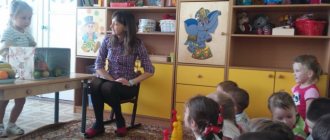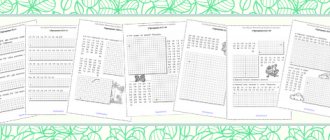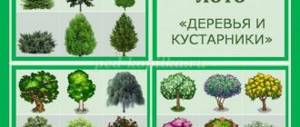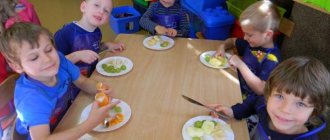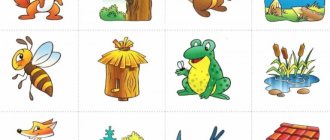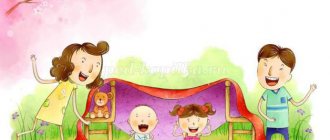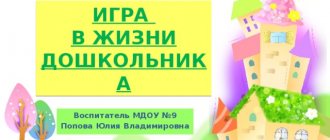CONTENT OF DIDACTIC GAMES
1st WEEK
FIND A ROOM FOR YOUR TOY
The purpose of the didactic game. Teach children how to properly place play materials and treat them with care.
Game tasks.
1. Playing with toys (2-3 new toys) - recite a poem, ask a riddle, find out by description, perform a song, etc.
2. Put toys in place. Evaluate together the correctness of the task: where is the best place for toys. The role of the leader can be played by the teacher or the child.
Equipment. Toys.
LET'S GET ACQUAINTED
The purpose of the didactic game. Learn to accurately and expressively perform simple dance movements, reflecting in them the changing nature of the music.
Game tasks.
1. Children become pairs facing each other and move in a side gallop to the music. At the end of the music, they give their friend a hand and say their name.
2. Perform dance movements as desired.
3. Moving forward in a circle, the partner is replaced.
4. At the strong sound of music, they scatter around the hall, at the signal they find a partner and, calling his name, stand in a circle.
Equipment. Audio recording (“Pair dance”, Karelian folk melody, or “Heel”, Russian folk melody; “Bulba”, white dance; “Dance”, music by T. Lomova).
WE PLAY ADVERTISING
Target. To form in children a positive attitude towards accessible, beautiful and understandable advertising.
Game tasks.
1. Children guess whose advertisements are hanging on the “tree” (they were placed in the forest by animals - the heroes of K. Chukovsky’s poem “Telephone”).
2. Having divided into teams, the children come up with their own ad and place it on the “tree”. Members of the other team must determine which of the animals will be interested in such advertising. For example: “We offer cabbage, tasty, sweet. It contains a lot of vitamins,” “Buy honey. Everyone needs it to be healthy.”
3. Children advertise “their business,” their product. For example: “Pancakes, pancakes, pancakes! Dad, mom, daughter!”, “Buy paintings. They will tell you about how beautiful the world is, how we live, sing, draw, dance,” “The best construction set for children is Lego.” He will teach you how to build fairy houses and make different animals for our zoo.”
4. “Pick up what you need for class.” Each team receives a set of cards depicting objects, toys, and aids necessary for different types of children's activities. The teacher names, for example: physical education, music class, drawing, modeling, and the children try to quickly select the attributes. They create an advertisement for “Our Games”. Which team attracted more participants to the game?
Equipment. Advertisements for “little animals” based on the content of K. Chukovsky’s work “Telephone”; pictures depicting vegetables, fruits, berries, objects, toys, aids; story pictures; paper, pencils, markers, glue, scissors; chips for awards.
WEEK 2
WHAT DOES A STUDENT NEED?
Target. Introduce children to the school supplies of a preparatory class student, teach them how to keep them in order and be able to quickly prepare for a lesson (in mathematics, reading, labor, physical education, drawing, rhythm). Reinforce the rules of behavior at school, in the classroom, during a lesson, during recess, in the cafeteria, on the playground.
Game tasks.
1. Children name what supplies the student needs.
2. At the teacher’s signal, the children in each row try to quickly and correctly prepare manuals for a specific lesson. The row that completes it first gets a flag.
3. Having been divided into groups, children depict game situations like “We are at recess” (in the dining room, in the gym, etc.).
Equipment. School supplies, chips for rewarding.
WHAT CHANGED?
Target. During the game, consolidate the concepts: above, below, between, to the right (right), to the left (left). Cultivate attention and observation.
Game tasks.
1. Introduce toys located on the table and shelves; determine their place in relation to one another.
2. After replacing toys, changing their place, tell what has changed.
3. Find the changes that have occurred in the group room (class).
Equipment. Toys, chips for rewarding.
FIND OUT WHO WE ARE?
Target. Teach children to understand a piece of music and compare musical images.
Game tasks.
1. Guess who enters the class after whom: a crybaby, a feisty one or a playful one.
2. Improvise musical and game images.
Equipment. Audio recording (plays “Crybaby”, “Crybaby”, “Frolic”, music by D. Kabalevsky).
Target. During the game, develop children's attention and interest in various colors and shades, a feeling of joy when perceiving the beauty in nature.
Game task. Each player receives a picture depicting a summer (autumn) landscape. By applying colored stripes to the image, the child selects the colors that are in his picture (the stripes are placed behind the braid attached at the bottom of the picture). Whoever composes the composition correctly and talks about it receives a set of postcards (for example, “Autumn Bouquet”; the children themselves make the postcards in advance).
Equipment. Pictures of landscapes, colored stripes, sets of postcards.
WEEK 3
TOP AND ROOTS
Target. To consolidate children's knowledge about vegetables (name, shape of fruits, stems, leaves, coloring, taste), about their meaning for humans. Cultivate a desire to grow the right plants.
Game tasks.
1. One group of children receives “roots” (onions, turnips, carrots, potatoes, etc.), and the other receives “tops” (tops). At the leader’s signal, all children find their pair (you need to create a whole from parts).
2. They pass through the “magic gate” (the correctness of the task is checked), after which they exchange “tops” and “roots”.
Game option. The game is played with paired pictures.
Equipment. Vegetables (paired pictures), chips for rewarding.
TRAVEL TO THE LAND OF ROAD SIGNS
Target. During the game, consolidate knowledge of the rules of the road for transport and pedestrians on city (village) streets. Cultivate attention and organization.
Game tasks.
1. A ride on a bus (made up of chairs or a large construction set), correct entry and exit, stops at traffic lights, a canteen, a medical aid station, etc.
2. Act according to the instructions of the police officer; monitor the traffic lights.
Equipment. Driver and policeman hats, road signs “Pedestrian crossing”, “Attention, children!”, “Turn”, “Road repair”, “Entry of vehicles prohibited”, “Sharp turn ahead”, etc.; traffic light, rod
COMPLETE A WHOLE FROM PARTS
Target. Learn to fold geometric shapes from individual parts; develop children's eye and coordination of movements. Cultivate resourcefulness.
Game tasks.
1. Consider geometric shapes (samples) and name them.
2. According to the teacher’s instructions, put together whole figures from individual parts.
3. Independent games: a) who will make the most figures in a certain time; b) who has a more beautiful pattern of geometric shapes.
Equipment. Flat geometric figures, their parts (of different colors), chips.
HELLO, AUTUMN!
Target. Teach children to perform movements in accordance with the rhythm and content of the song.
Game tasks.
1. One participant in the game depicts autumn (he stands in a circle), the second child depicts rain (located on the side). Children holding hands move in a circle and sing a song. Autumn answers the questions contained in the song, and the children perform the appropriate actions.
2. At the end of the song, the children run away to hide from the rain, and the rain catches up with them, clapping its hands.
3. To the accompaniment of light music, children run out from under the umbrella (roof), stand in a circle, and the game is repeated.
Equipment. Audio recording (“Hello, autumn!”, music by V. Vitlin, lyrics by E. Blaginina), autumn and rain costumes, autumn leaves, garlands, umbrella.
COME UP WITH A DRAWING
Target. To develop the creative imagination and imaginative thinking of children in play, to teach them to give an objective assessment of their work and teamwork.
Game task. Complete each of the four geometric shapes drawn on the board (circle, triangle, semicircle, rectangle) so that you get interesting drawings. For example, from a circle - a ball, a bun; from the semicircle - a mouse, a sailboat; from a triangle - a cockerel, etc. The one who has created the most drawings based on one geometric figure wins.
2-3 groups of children can take part in the game.
Equipment. Colored crayons, badge (souvenir, craft) for awarding.
WEEK 4
GET IT BY YOUSELF
Target. Teach children to correctly form sentences with a given number of words.
Game task. Come up with sentences of two, three, four, five words. The first child to make a sentence gets a chip. The one with the most chips wins.
Game option. You can give supporting words to make sentences.
Equipment. Chips for rewarding.
GUESS, WE WILL GUESS
Target. In the game, clarify children's knowledge about garden plants, name their characteristics, describe and find them by description.
Game task. Children describe any plant in the following order: shape, color, taste, smell. The driver should recognize the plant from the description.
Equipment. Vegetables, fruits, berries, leaves (in kind or in pictures), chips for rewarding.
LEARN THE SONG
Target. Recall the names of familiar songs from the picture and repeat their content.
Game tasks.
1. Participants in the game are divided into 2-3 groups, choose 2-3 pictures depicting objects and together find out what songs they remind of the content of.
2. Children of one group show their pictures and sing songs. The rest must find out the name of the song and determine whether the task was completed correctly.
At the end of the game, the best choir is awarded.
Game option. The group can perform a song without naming it, and the guys must find out what object is shown in the picture.
Equipment. A set of pictures depicting objects (Christmas tree, birch tree, bird, flag, autumn leaves, etc.)” audio recording (phonogram).
WEEK 5
WHAT DO YOU HAVE?
Target. Teach children to write a sentence on a specific topic.
Game task. Each child receives an envelope (bag) containing a small object (toy). You need to make a sentence with the name of the item he received. At the signal from the presenter, he speaks his proposal.
The game is repeated 3-4 times.
Equipment. Envelopes (bags) with objects or toys, chips.
JOURNEY TO THE COLLECTIVE FARM (STATE FARM)
Target. During the game, expand children's knowledge about the life of the people of the collective farm village, cultivate respect for agricultural professions. Develop coherent speech.
Game tasks.
1. Select pictures about the life of collective farmers, their work (work in the field, in the garden, in the garden, on the farm, etc.); talk about them, characterizing the professions of field farmer, milkmaid, combine operator, poultry worker, etc.
2. Talk about the work of your parents (rural children), grandparents.
3. Find out the content of the pictures (children exchange them among themselves) by the child’s imitation of actions performed by people of different rural professions.
Whoever identifies the content of the picture more correctly and quickly gets a chip.
Equipment. Pictures, children's books, photo illustrations, chips.
POST YOUR FIGURE
Target. Teach children to act according to a model, remember and accurately reproduce it. Cultivate attention and perseverance.
Game task. Consider and remember the sample. Lay out the figure yourself, check the correctness of the work done (check with the sample).
Equipment. Boxes with colored sticks of different sizes, samples, chips.
WE ARE THE DRUMMERS
Target. Teach children the simplest techniques for playing the drum (holding their hands correctly, maintaining general dynamics, tempo), and performing movements in accordance with the three-part form of music.
Game task. One group of children plays the drums, the children of the second group learn the melody and perform movements to the music (marching, clapping, squats, etc.). Which group did the task better?
Equipment. Audio recording (“Drummers”, music by D. Kabalevsky; “On the mountain there is a viburnum”, Russian folk song in the style of Yu. Chichkov), drums.
WEEK 6
COME UP WITH A PROPOSAL
Target. Learn to compose sentences with a word given in a certain form; develop speech activity.
Game task. The teacher names the word, and the child makes a sentence with it. For example, the word “nearby” is the sentence: “# I live not far from the kindergarten” (words can be of different forms: mom, winter, came, good, etc.).
Whichever child made a mistake pays a phantom, and for the correct answer receives a chip.
Equipment. Subject pictures, chips.
INVITATION TO VISIT
Target. Teach children to correctly say their last name, first name, home address; follow the rules of behavior when visiting, be polite, show attention and care for others.
Game tasks.
1. The child introduces himself to the children and invites them to visit (for a birthday, holiday, etc.), and correctly names his home address.
2. The teacher and children discuss how to behave when visiting and what gift to prepare for the birthday boy.
3. The teacher (or Petrushka, a character from a fairy tale) invites children to the kindergarten to a performance (puppet theater, picture theater). The teacher (children) names the kindergarten number and address.
4. Puppet show (picture theater) “Let’s get acquainted.”
Equipment. Puppet theater (or picture theater).
FUN GAMES - PUZZLES
Target. Promote the development of children's intellectual abilities.
Game tasks.
1. Make two squares from seven sticks.
2. Create the desired pattern from several geometric shapes.
3. Name quickly: 5 different girls' names; 5 boys names; 5 flowers; 5 pets; 5 items a student needs.
4. Who can arrange 3 sticks in different ways? Who will complete the task with 4 and 5 sticks?
Equipment. Counting sticks, samples of patterns for making, chips.
MAKING MUSIC
Target. Learn to come up with a melody based on the words of familiar quatrains; develop singing skills.
Game task. Children (5 people) choose cards with text at will, then they must “read” it, and I will come up with a melody. The rest of the guys (jury members) watch their actions, listen to the performance, and discuss the choice of the best option. The best “composer” is awarded a diploma (winner badge).
Game option. The task is performed by a group of children. The best creative team is awarded a diploma.
Equipment. Cards with text (plot), diploma, musical instruments (optional), audio recording (phonogram).
WEEK 7
REMEMBER THE LETTERS
Target. Exercise children in recognizing and memorizing letters.
Game task. All players receive object pictures. Having seen the letter placed by the teacher on the typesetting canvas, the children put down pictures depicting objects whose names begin with this letter (the letter is in the middle of a word, at the end of a word). The one with the most correctly selected pictures wins.
Equipment. Object pictures, letter box, typesetting canvas.
WHAT DOES WHO NEED?
Target. During the game, children should be trained in the classification of objects and the ability to name objects necessary for people in rural professions. To cultivate love and respect for work, the desire to provide all possible assistance to adults.
Game task. The presenter (teacher or child) names the person by profession (field farmer, tractor driver, beekeeper, agronomist, etc.) - Children name what each of them needs for work. The one who names the most items wins.
Equipment. Illustrative material on the topic “Work on a collective farm”, subject pictures, chips for rewarding.
OUR ORCHESTRA
Target. Teach children to distinguish the timbre coloring of the sound of musical instruments.
Game tasks.
1. The presenter (teacher or child), behind the screen, plays one of the instruments. Children guess what instrument it sounds. The one who answers correctly gets a chip.
2. Children who answered correctly will organize an orchestra. A conductor is chosen. Imitating playing instruments, the orchestra begins the performance: first the trumpeters - boom-boom-boom..., then the drummers enter - tra-ta-ta..., violinists - tili-tili-tili..., cymbalists - la-la-la... etc.
Equipment. Children's musical instruments (trumpet, drum, violin, cymbals, pipe, bell, etc.), chips, audio recording (phonogram).
RAINBOW
Target. The game reinforces children's ideas about primary and secondary colors.
Game tasks.
1. Children arrange the sticks to make a rainbow - the solar spectrum - red, orange, yellow, green, blue, indigo, violet.
2. Select sticks painted in primary colors and select additional colors for them.
3. Put on hats (colors of the spectrum) and at the presenter’s signal “Sunny!” run (“walk”) all over the site; to the signal “Rain!” gather in a “rainbow” and say the words:
And I am a rainbow-arc and high and tight,
I'll give you a bucket full of rain.
Equipment. Reproduction with the image of a rainbow, multi-colored sticks, hats.
WEEK 8
LIVING SYLLABLES
Target. Exercise children in reading straight syllables.
Game task. Divide the game participants into three identical subgroups. One subgroup receives cards with consonants, the second - with vowels. At the teacher’s signal, the children come together in pairs, holding up cards with letters. Children from the third subgroup read the resulting syllable.
Equipment. Cash register of letters, cards with letters, chips.
WHAT CHANGED? (WHAT'S MISSING?)
Target. Teach children to describe a toy (object) from memory, develop visual memory.
Game tasks.
1. Children remember all the toys (objects) that are on the table. The leader hides the toy or changes its position, and the children (one by one or together) find out what has changed (or what has disappeared). Name the toy and describe it.
2. When naming or describing a new toy, you must indicate how and what games you can play with it.
3. Playing with new toys.
Equipment. Toys.
TANGRAM (geometric constructor)
Target. Teach children to recreate simple figures from geometric shapes: bunny, cockerel, bird, etc., using 7 figures. Offer to tell how the child thinks about completing the task, and then check the correctness of the solution. Look for solutions to problems collectively, give all playing children the opportunity to speak out.
Option. On a piece of checkered paper, make a poster of various geometric shapes (story picture).
Equipment. Geometric construction set, sheets of checkered paper, simple pencils (pens).
SUPERMARKET
Target. To consolidate children's knowledge of ordinal counting and the composition of numbers. Develop speech and thinking.
Game tasks.
1. Choose the necessary vegetables and fruits in the store; calculate their cost and pay to the cashier; give the check received from the cashier to the controller.
2. Name the products and tell what can be prepared from them.
Equipment. Attributes for the game "Shop".
GUESS THE BELL
Target. Learn to distinguish between high, middle and low sounds; develop children's ear for music.
Game task. Children receive mugs in red, yellow and green. The leader (teacher or child) has 3 bells - large, medium and small. The presenter calls them one by one. Children raise their mugs according to the sound: a red circle - to the low sound of a large bell; yellow - medium; green - for the high sound of a small bell. The game can be played with a metallophone (the presenter alternates playing in the upper, middle and lower registers).
The jury records the mistakes of the participants in the game.
Equipment. 3 musical bells, colored mugs.
SCULPTORS
Target. Fix constructive (an object is created from separate parts) and plastic (an object is created from a whole piece by stretching) methods of sculpting. Independently distribute tasks in group work. Develop imaginative thinking and creative imagination.
Game tasks.
1. Two groups of children are given the task of creating a sculptural composition (for example, based on the content of the work “Grandfather Mazai and the Hares” by N. Nekrasov), using the products they made in the modeling class and adding new ones. You are given 20-30 minutes to work.
2. Collective viewing and discussion of works. The evaluation takes into account the expressiveness of the image.
3. Acting out created images using literary text (tabletop theater).
Creative teams receive diplomas and their works are offered for exhibition.
Equipment. Plasticine or clay, stacks, boards, auxiliary material, diplomas.
What is a sound game and what are its features?
To answer this question, it is necessary to turn to the well-known concept of symbolic play in psychology. Symbolic game is “a type of game in which reality is reproduced in the form of symbols, signs, and game actions are performed in an abstract symbolic form.” A symbol is “a sign associated with a specific object, idea, belief, thought and feeling related to that part of reality that this sign represents.” A sign is “any conventional image representing reality in symbolic form.”
Based on these definitions, we can state that any sound is also a kind of symbol, a sign that carries an idea of a certain object or phenomenon, and playing with sounds is a symbolic game. Thus, a sound game can be defined as a type of symbolic game, which is based on imitation, imitation of the sounds of living and inanimate nature, human activity. In such a game, a sound (sign) is considered in the form of a conventional image, representing reality in symbolic form.
Sound games are based on sound, musical and linguistic improvisation, children's imitation of the sounds of nature and human activity.
In the process of sound games, children are given ideas about the sounds of the surrounding world and their relationship with music, about the means of musical expressiveness of nature and music, about the features of musical and speech intonations, about the meaning of silence and the expressiveness of the “sound” of pauses, etc.
The founders of the use of playing with sounds in music pedagogical practice can be called Carl Orff and Zoltan Kodai. In modern music pedagogy, these issues are dealt with in particular by Borovik T.A., Tyutyunnikova T.E., Zhilin V.A.
